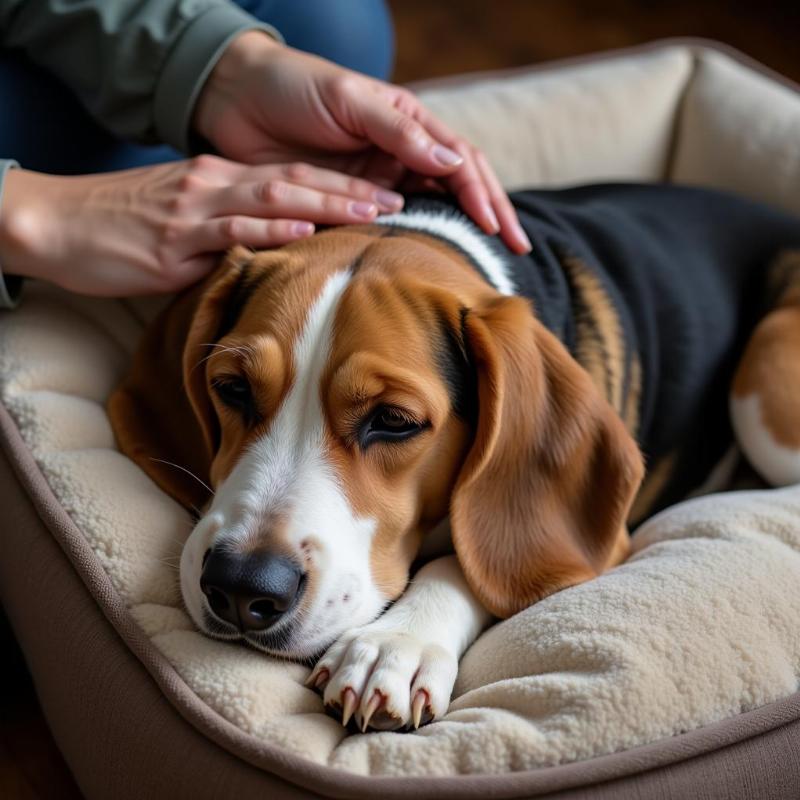Purring isn’t just for cats! While less common than in our feline friends, dogs can and do purr. If you’re wondering why your dog purrs when you cuddle him, you’ve come to the right place. This heartwarming behavior can stem from several reasons, and understanding them can deepen your bond with your furry companion. Let’s explore the fascinating world of canine purring.
Decoding the Canine Purr: Contentment and Communication
One of the most common reasons dogs purr is pure contentment. Just like a cat purring on your lap, a dog’s purr can signify that he’s feeling happy and relaxed in your presence. Cuddling provides warmth, physical contact, and a sense of security, all of which contribute to a dog’s overall well-being. When your dog snuggles in close and starts to purr, it’s a clear sign he’s enjoying the affection and feeling loved. This purr is often soft and low, almost a gentle rumble.
Is your dog purring with his tail wagging? This combination is almost certainly a sign of happiness and contentment. It’s his way of saying, “I love this!” However, purring isn’t always an expression of pure joy.
Beyond Happiness: Other Reasons for Purring
While contentment is a primary driver, dogs may also purr due to other reasons. Sometimes, a purr can be a sign of appeasement. If your dog feels anxious or insecure, he might purr as a way to diffuse a potentially tense situation. This is especially common in puppies or dogs new to a home. They might purr when meeting new people or other dogs as a way of saying, “I’m friendly, please don’t hurt me.”
Furthermore, a purr can also be a form of self-soothing. Just as humans might hum a comforting tune, dogs might purr to calm themselves down in stressful situations. For instance, a trip to the vet or a loud thunderstorm might trigger this self-soothing purr. Pay attention to your dog’s body language and the surrounding environment to understand the context of his purring.
Is Your Dog Purring Because of Pain?
In some cases, a dog might purr due to pain or discomfort. This purr often sounds different from a contentment purr – higher pitched, more strained, and possibly accompanied by whimpering or other signs of distress. If you suspect your dog is purring due to pain, consult with your veterinarian immediately.
Understanding Your Dog’s Unique Language
Each dog is an individual, and their purring can have subtle nuances in meaning. Pay close attention to your dog’s body language, vocalizations, and the surrounding context to understand the message he’s trying to convey.
 Dog purring while being petted by owner
Dog purring while being petted by owner
Expert Insights on Canine Purring
Dr. Emily Carter, a leading veterinary behaviorist, explains: “Canine purring is a fascinating vocalization that deserves more attention. It’s not as well-studied as feline purring, but we know it plays a significant role in canine communication and emotional regulation.”
Dr. Carter further emphasizes, “Observing the accompanying body language is crucial to accurately interpret a dog’s purr. A relaxed posture, soft eyes, and a wagging tail alongside a purr typically indicate contentment. However, a tense body, tucked tail, and whale eyes paired with purring may suggest anxiety or appeasement.”
Strengthening Your Bond Through Understanding
By understanding the different reasons behind your dog’s purrs, you can better respond to his needs and strengthen your bond. Whether it’s a purr of pure joy during cuddle time or a purr of anxiety in a new situation, recognizing the underlying emotion allows you to provide the appropriate comfort and support.
The next time your dog purrs while you cuddle him, take a moment to appreciate the special connection you share. It’s a beautiful form of communication that speaks volumes about the love and trust between you and your furry companion.
FAQ
- Do all dogs purr? No, not all dogs purr. It’s less common than in cats, and some breeds seem to purr more frequently than others.
- How does a dog’s purr sound? A dog’s purr can range from a low rumble to a higher-pitched, almost vibrating sound.
- Should I be concerned if my dog suddenly starts purring? Not necessarily. Observe your dog’s overall behavior and body language to determine the context of the purr. If you notice any signs of pain or distress, consult your veterinarian.
- Can a dog purr and growl at the same time? It’s unusual, but possible. This could indicate conflicting emotions and warrants careful observation.
- How can I encourage my dog to purr? Creating a calm and loving environment, providing gentle petting and cuddling, and engaging in activities your dog enjoys can encourage purring.
- Is a dog’s purr the same as a cat’s purr? While both are forms of vocalization expressing contentment and other emotions, the mechanisms behind the sounds are thought to be different.
- Can a dog purr when it’s not being cuddled? Yes, dogs can purr in other situations, such as when they are eating, playing, or even when they are feeling anxious or in pain.
Beautdogs.us is your premier online destination for all things dog-related in the US. We offer expert advice on dog breeds, care, and products, providing a trusted resource for both new and experienced dog owners. Our passion is helping you nurture the special bond with your canine companion. Discover a wealth of information on our website, Beautdogs.us, and connect with us for personalized support at [email protected] or +1 501-555-7529.